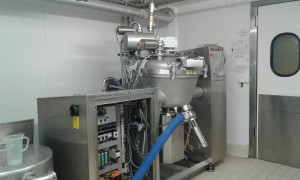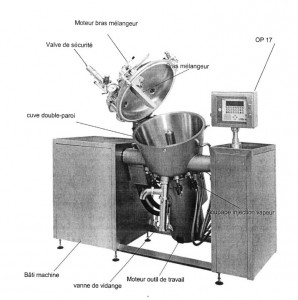At around 7:30 a.m., a kneader at a cheese factory malfunctioned, throwing off scalding hot cancoillotte (a runny cheese). The kneader was turned on and solid ingredients were added and mixed together at 80 °C. Then, a second program started up and progressively raised the temperature to more than 100 °C. Seeing the temperature rise directly to 90 °C, the employee working at the kneader called her manager. The program was stopped. Two other employees joined them. As the kneader’s display indicated a high level of pressure, the manager opened the venting valve. The display then indicated that the pressure dropped back down to 95 °C. Thinking that the pressure had been vented, the employees decided to open the lid in order to close it back again and restart the program. They activated the lid release button, which unlocked the cylinders. Suddenly, all four workers were hit by a jet of cancoillotte. They were taken to hospital for second and third-degree burns to the neck, face, and arms.
During its visit to the site, the inspection authorities for classified facilities saw that the kneader is covered by the pressure equipment directive. As a result, it must be inspected every 40 months and requalified every 10 years. However, the operator did not carry out any inspections or requalifications of the kneader. For its part, the manufacturer should have requested a conformity assessment of the kneader from a notified body before placing it on the market. In addition, the kneader was not fitted with any safety devices preventing the lid being opened when its bowl is under pressure. This means that workers can open the lid once they activate the venting valve. Inconsistencies in the volume of the bowl and the valves were found in the kneader’s technical documentation. There is one tared at 1.5 bar on the bowl, but the manual refers to a non-existent valve on the double jacket.
The unusually high pressure in the kneader could have been caused by a malfunction of the electronic box that allowed steam to be injected into the bowl at a pressure of 4 bar once the pressure at the boiler outlet reached 8 bar. The program is set such that steam at a pressure of 4 bar enters the bowl for a predetermined time, influencing its final pressure. The program is not based on pressure but on the steam supply time. Although the original valve is cleaned daily, it may have become blocked when the pressure was exceeded.
A specialist body contacted to conduct an analysis found multiple nonconformities. As the manufacturer is no longer in business, it would be extremely tough to bring the kneader back into compliance. As a result, the kneader was not returned to service. In addition to the material damage, the accident resulted in significant operating losses due in particular to the shutdown in operations.
The operator is contemplating about how operations should be organised in the future, including:
- a new kneader that will be inspected by a body before being placed in service;
- an operating procedure adapted to the new manufacturing process;
- exercises and even more frequent workstation safety audits after a new operating procedure is written.






